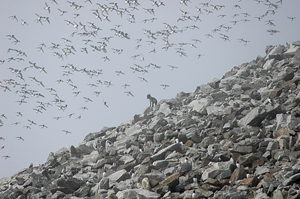Bellsund's wildlifeBy Jørn Henriksen, Øystein Overrein
You can register your observations of marine mammals around Svalbard in the Norwegian Polar Institute’s database Marine Mammals Sightings. 
In April, when the seabirds have returned, Bellsund teems with life. There is a constant buzz of little auks, Brünnich’s guillemots and northern fulmars in the fjord. If there is drift ice, once in a while a walrus or a seal drifts by. In Bellsund there are two sites of special interest when it comes to birdlife: Midterhuken and Vårsolbukta, located on each side of the entrance of Van Mijenfjorden. At Midterhuken on the southern shore there are large, breeding populations of Brünnich’s guillemot, black-legged kittiwake, little auk and northern fulmar. There are also about 30-40 pairs of pink-footed geese nesting below the bird cliffs. The same species breed at Vårsolbukta in the north, in the bird cliff Ingeborgfjellet. The moss tundra below Ingeborgfjellet is an important pasture land for migrating barnacle geese, pink-footed geese and brent geese during the northbound spring migration – in the transition between May and June flocks of several hundred geese can be seen grazing here. The Svalbard reindeer also like the lush flats adjacent to the bird cliffs. Pink-footed geese breed in the area and are vulnerable to disturbances in June and July. Barnacle geese breed at several places in the area – north of Braganzavågen in from Svea, at Blåhuken, on the islands of Reiniusøyane off Vårsolbukta, at Diabaspynten and on the islets St. Hansholmane at Nordenskiöldkysten. Common eiders nest in several localities in the area, the largest one being the small island Eholmen at the entrance of Van Keulenfjorden with approximately 2500 breeding pairs in “good years”. There are also several hundred pairs of barnacle geese breeding on Eholmen. Black-legged kittiwakes nest at the mountain Observatoriefjellet, located at the end of Recherchefjorden. Arctic terns nest at Mariaholmen. The area is full of little auks, and most of their colonies are located like pearls on a string in the scree slopes between Dunderbukta and Recherchefjorden. At Aldegondaberget in Van Keulenfjorden and at Kolfjellet on the north side of Van Mijenfjorden there are other little auk colonies. For the ringed seal, Van Mijenfjorden and Van Keulenfjorden are important moulting areas, since this is an area where the fast ice remains long into the spring. Aerial population counts in 2002 and 2003 showed that as many as 2000 ringed seals can be on the ice in May and June. The ringed seal is important prey for the polar bears. Most polar bears pass through the area from the west and across to the east coast, but some also stay in the area year-round. In Bellsund you can also see walrus, white whale and bearded seal. During the early 20th century there was a hunting industry for white whales in the area, and a land-based station was built in Ingebrigtsenbukta in Van Keulenfjorden. There is a small number of harbour seals in Kaldbukta, on the north side of Van Keulenfjorden. There are no known rivers with Arctic char in the area, but several Arctic chars are caught each year in nets in Van Mijenfjorden. Updated March 2015 |
The Cruise Handbook is also available in book formHard cover with numerous pictures - 249 pages - NOK 249.00 Norwegian Polar Institute |
 Norsk
Norsk